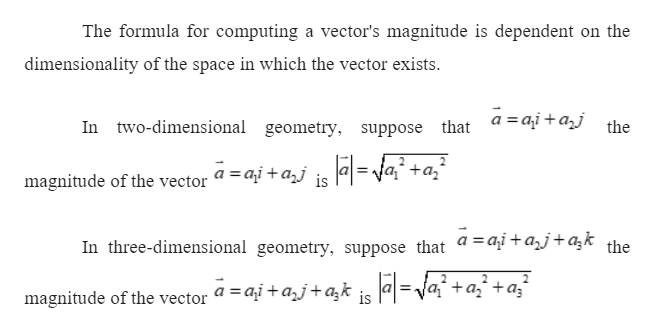Table of Contents
Introduction to Magnitude of a Vector
Vectors are used extensively in mathematics to describe values that have both direction and quantity. The magnitude of a vector, often known as its length, gives crucial information about the intensity or size of the quantity it represents. Understanding how to compute and comprehend the magnitude of a vector is critical in physics, engineering, and everyday life.
What is the definition of magnitude of vector
The magnitude of a vector reflects its length or size without taking into account its direction. It’s a scalar quantity represented by |v|, where v represents the vector under consideration.
Formula for magnitude of a vector

How to find the magnitude of a vector
- Determine the vector’s components in the given dimension.
- Consider the number of dimensions when calculating the magnitude.
- Square each component, add the squared values, then compute the square root of the sum.
Solved Examples on Magnitude of Vector
Example 1:
Given a vector u = (3, 4) in 2D space, find its magnitude.
Solution:|u| = √(3² + 4²) = √(9 + 16) = √25 = 5
Example 2:
For a vector w = (1, 2, 3) in 3D space, calculate its magnitude.
Solution:|w| = √(1² + 2² + 3²) = √(1 + 4 + 9) = √14
Also Check:
Frequently Asked Questions on Magnitude of a Vector
What is the significance of magnitude of vector?
Vector magnitude provides information about the intensity or scale of a quantity, regardless of its direction. It's essential for various calculations in physics, engineering, and geometry.
What is the magnitude of three different unit vectors along the axes?
The magnitude of unit vectors along the axes is always 1. In three-dimensional space, the unit vectors are î for the x-axis, ĵ for the y-axis, and k̂ for the z-axis. The magnitude of î is |î| = 1. The magnitude of ĵ is |ĵ| = 1. The magnitude of k̂ is |k̂| = 1. Unit vectors have a length of 1 and point in the direction of their respective axes. They serve as reference directions in coordinate systems and are used to describe other vectors' components and directions.
What is the magnitude of a vector in three dimensional space?
The magnitude of a vector in three-dimensional space tells you how long the vector is. Imagine you have a vector that points in three directions: left-right, up-down, and front-back. To find its magnitude, you use the formula √(x² + y² + z²), where x, y, and z are how far the vector goes in each direction. This gives you a single number that represents how big the vector is.
What is the magnitude of resultant vectors of two vectors?
The magnitude of the resultant vector formed by adding two vectors is calculated using the Pythagorean theorem. In 2D, it's √(Rx² + Ry²), and in 3D, it's √(Rx² + Ry² + Rz²), where Rx, Ry, and Rz are the components of the resultant vector along respective axes.
If the magnitude of resultant vector of two vectors having magnitudes 5 and 3 is 2 then what is the angle between them?
Angle is 180 degrees
How does the magnitude of the vector related to unit vector?
Unit vectors have a magnitude of 1 and are used to represent direction. The magnitude of a vector can be understood by the relative scale of its components compared to the unit vectors
Can the magnitude of the vector is negative?
No, the magnitude of a vector is always a non-negative scalar value.








